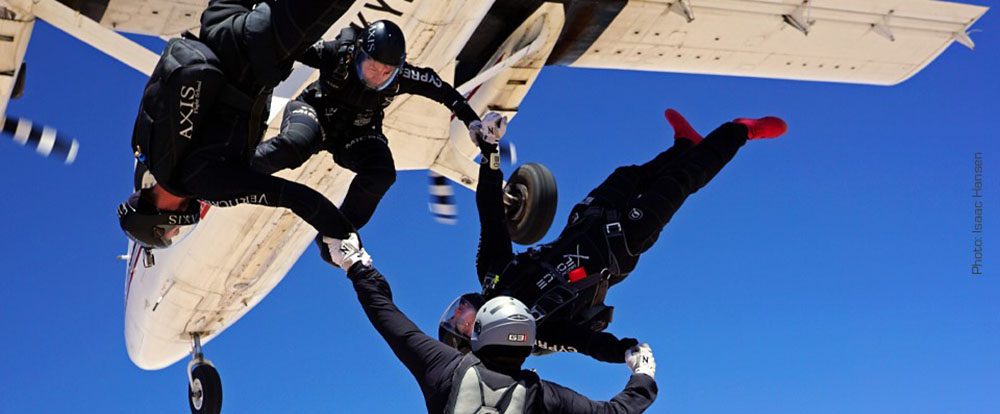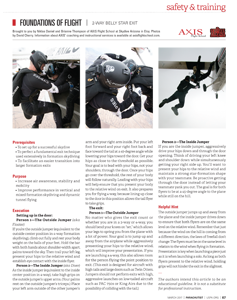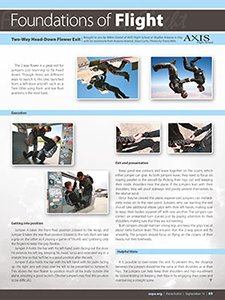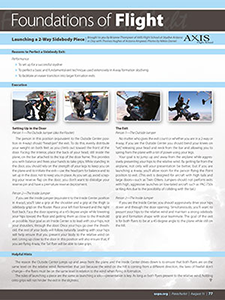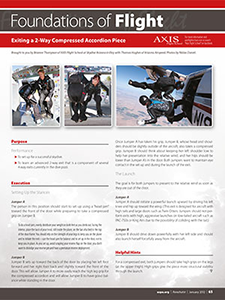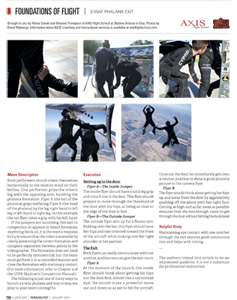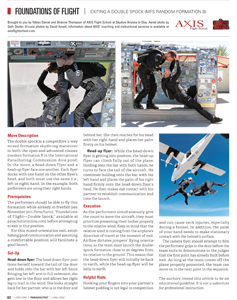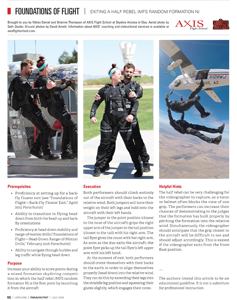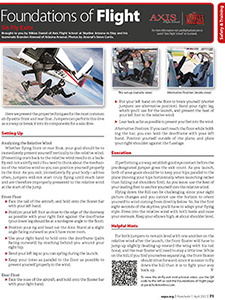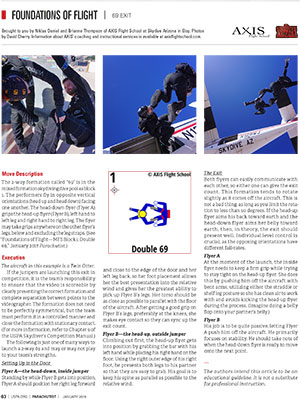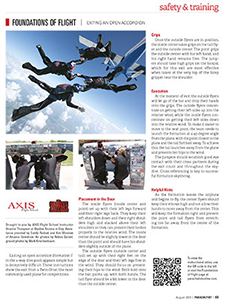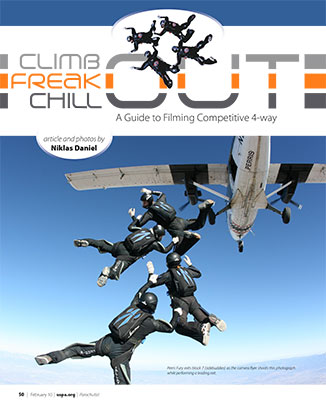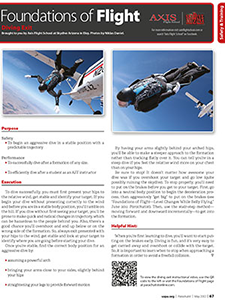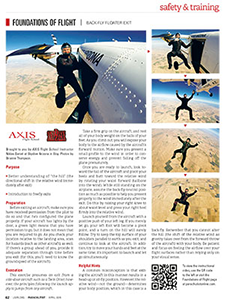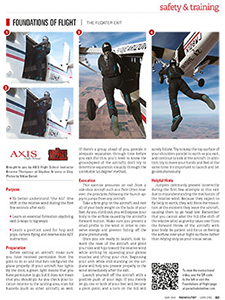Table of Contents
Jump to a chapter/section by clicking on it
or scroll through the complete topic.
Chapter 1: 2-Way
Chapter 2: 4-Way
Chapter 3: Camera
Chapter 4: Solo Skills
Chapter 1: 2-Way

2-Way Belly Star Exit
Article by Niklas Daniel and Brianne Thompson. Visuals by by David Cherry.
Increase your air awareness, stability and mobility, and improve your performance in vertical and mixed formation skydiving and dynamic tunnel flying.
[ Full Article ]

Two-Way Head-Down Flower Exit
Article by Niklas Daniel and Brianne Thompson. Visuals by by Niklas Daniel.
The 2-way flower is a great exit for jumpers just learning to fly head down. Though there are different ways to launch it, this one, launched from a left-door aircraft such as a Twin Otter using front- and rear-float positions, is the most basic.
[ Full Article ]

Launching a 2-Way Sidebody Piece
Article by Niklas Daniel and Brianne Thompson. Visuals by by Niklas Daniel.
Set up for a successful skydive, perfect a basic and fundamental exit technique used extensively in 4-way formation skydiving, and facilitate an easier transition into larger formation exits.
[ Full Article ]

Exiting a 2-Way Compressed Accordion / Periscope (MFS Block 7)
Article by Brianne Thompson with Thomas Hughes. Visuals by by Niklas Daniel.
Set up for a successful skydive and learn an advanced 2-way exit that is a component of several 4-way exits currently in the dive pool.
[ Full Article ]

2-Way Phalanx Exit
Article by Niklas Daniel and Brianne Thompson. Visuals by by David Wybenga.
Learn all about the 2-Way Phalanx exit, from move description to execution and helpful hints.
[ Full Article ]


Exiting a Double Spock (MFS Random B)
Article by Niklas Daniel and Brianne Thompson. Visuals by by Seth Studer (aerial) and David Amett (ground).
Learn all about exiting a Mixed Formation Skydiving Random B (Double Spocl), from move description, prerequisites, set-up, to execution and helpful hints.
[ Full Article ]
[ Video ]


Exiting a Half Rebel (MFS Random N)
Article by Niklas Daniel and Brianne Thompson. Visuals by by Seth Studer (aerial) and David Amett (ground).
Increase your ability to score points during a mixed formation skydiving competition in which the half rebel (MFS random formation N) is the first point by launching it from the aircraft.
[ Full Article ]
[ Video ]


Sit-Fly Exits
Article by Niklas Daniel with Brandon Atwood. Visuals by by Steve Curtis.
Learn the proper techniques for the most common sit-fly exits: front and rear float. Jumpers can perform this dive as a 2-way or break it into its components for a solo dive.
[ Full Article ]
[ Video ]

69 Exit (MFS Block 1)
Article by Niklas Daniel and Brianne Thompson. Visuals by by David Cherry.
The 2-way formation called “69” is in the mixed formation skydiving dive pool as block 1. Learn more about this exit, where performers fly in opposite vertical orientations (head up and head down) facing one another.
[ Full Article ]
Chapter 2: 4-Way


Exiting an Open Accordion (4-Way FS Random F)
Article by Brianne Thompson with Sandy Radsek and Kim Winslow. Visuals by by Niklas Daniel (air) and Mark Kirschenbaum (ground).
Exiting an open accordion (formation F in the 4-way dive pool) appears simple but is deceptively difficult. These instructions show the exit from a Twin Otter, the most commonly used plane for competitions.
[ Full Article ]
[ Video ]
Chapter 3: Camera

A Guide to Filming FS 4-Way — Climb Out, Freak Out, Chill Out
Article by Niklas Daniel. Visuals by by Niklas Daniel.
This article is for jumpers who already have some experience flying camera and are trying to expand their knowledge of how to film formation teams in a competition setting. I will focus mainly on 4-way, because I believe it to be the most difficult formation skydiving discipline to film (aside from vertical formation skydiving), due to the many different exits and faster key speeds. However, once you have a firm grasp of shooting 4-way, the same principles can be applied to 8-way and larger formations.
[ Full Article ]

VFS Camera — Tricks and Traps
Article by Niklas Daniel and Sara Curtis; . Visuals by by Niklas Daniel.
Vertical Formation Skydiving (VFS) is a new and strongly emerging discipline, which combines the body-flight skills of freeflying and the mental skills of formation skydiving. In the past, very few skydivers have had the ability to take part in this discipline because it takes a certain level of proficiency of flight, and a complex understanding of formations. Today wind tunnels are springing up all over the globe, assisting skydivers in their quest for awesomeness. (…) In this article we are going to take a closer look at the camera flyer. Even though there may be some similarities in the responsibilities between camera flyers on the horizontal and vertical axis, with the addition of a greater fall rate speed and added dimensions of the formations, filming VFS is probably one of the most difficult disciplines to shoot. Here we check out some tricks and traps of this fun and challenging position.
[ Full Article ]
Chapter 4: Solo Skills


Diving Exit
Article by Niklas Daniel and Brianne Thompson. Visuals by by Niklas Daniel.
Safety: begin an aggressive dive in a stable position with a predictable trajectory. Performance: successfully dive after a formation of any size or efficiently dive after a student as an AFF instructor.
[ Full Article ]
[ Video ]


Back-Fly Floater Exit
Article by Niklas Daniel. Visuals by by Brianne Thompson.
Get a better understanding of “the hill” (the directional shift in the relative wind immediately after exit) and and introduction to freefly exits.
[ Full Article ]
[ Video ]


The Floater Exit
Article by Brianne Thompson. Visuals by by Niklas Daniel.
Better understand “the hill” (the shift in the relative wind during the first few seconds after exit). Learn an essential formation skydiving skill (2-ways to big-ways) and a position used for hop and pops, camera flying and reserve-side AFF instruction.
[ Full Article ]
[ Video ]


Sit-Fly Exits
Article by Niklas Daniel with Brandon Atwood. Visuals by by Steve Curtis.
Learn the proper techniques for the most common sit-fly exits: front and rear float. Jumpers can perform this dive as a 2-way or break it into its components for a solo dive.
[ Full Article ]
[ Video ]
